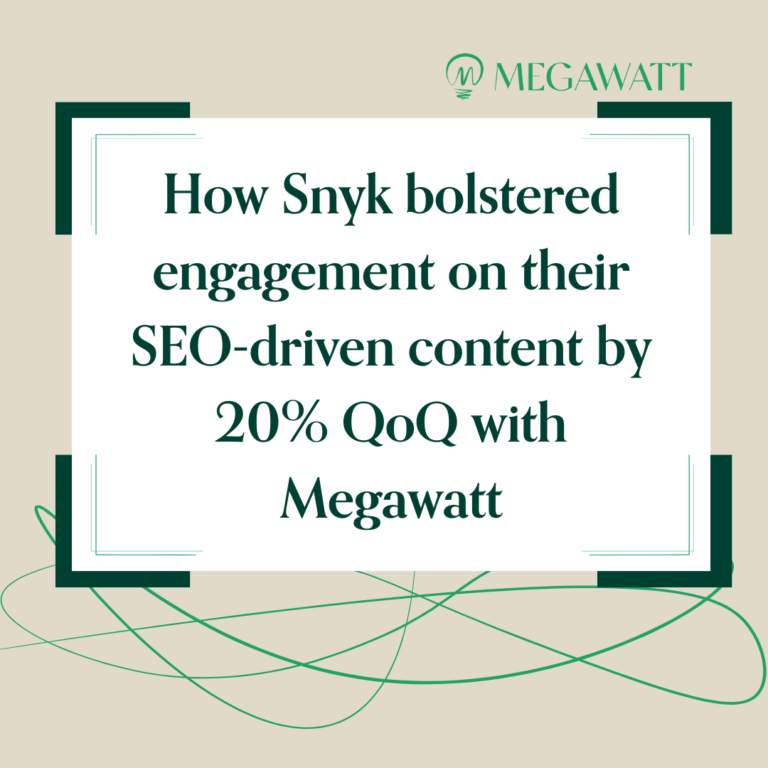If there’s anything we can learn from 2023, it’s that content marketing is nothing like Kevin Costner’s Field of Dreams. We can build (write) it, but we can’t guarantee the clients will come…at least, not without a little extra strategic effort.
With the ongoing economic downturn, businesses must work twice as hard to reach prospects. In fact, 64% of executives say their procurement process is becoming more rigorous, and 55% say nice-to-have products and services will be first on the chopping block should budget cuts become necessary.
But don’t worry; there are ways marketers can make a very real impact on both conversion rates and retention in this challenging market. One key strategy is through high-quality thought leadership content, which 50% of decision-makers say has a greater impact on their purchasing decisions during a downturn than when the economy is booming.
Buckle up; it’s time to dust off (or kick off) the thought leadership portion of your content marketing strategy.
What Is Thought Leadership?
Thought leadership content establishes an individual or a company as a trusted resource in their field. Content marketers partner with internal experts or thought leaders to generate content that provides actionable tips and strategies that address industry trends, include real-world examples and present new ways of thinking about common challenges.
Thought leadership marketing is unique because it focuses strongly on providing value — rather than pushing a product or making a sale — and it’s often seen as more credible and trustworthy. This combination of value and trust is vital to lead generation, motivating prospects to continue visiting your website, engaging with your content, and, eventually, getting on a sales call.
In addition to building trust with prospects in your network, thought leadership content can help broaden your reach. Google’s algorithm prioritizes useful content, meaning the more valuable your content is to your target audience, the higher the potential is for it to rank with search engines.
Pillars Of Thought Leadership
Thought leadership strategies are about more than producing useful content. To be successful, content marketers should also consider the four pillars of thought leadership.
| 4 Pillars of Thought Leadership | |
| Expertise | A thought leader’s title, work history, and publications should align with the subject matter they’re writing about. This is a quick way to prove credibility. |
| Reach | Subject matter experts with a wide network of in-person and online connections are ideal candidates for thought leadership. |
| Frequency | Publishing frequently and consistently is key to building a thought leadership platform, as it keeps them top of mind. |
| Actionability | Thought leaders must be able to translate their experiences and strategies into scalable and replicable systems that their audience can easily apply.. |
Thought Leadership Types
Thought leadership content can take many forms, including:
- Blog posts
- eBooks
- Whitepapers
- Podcasts
- Webinars
- Speaking at in-person events
- Articles on third-party publications
- Proprietary research
TLDR;
What thought leadership content is:
Insightful and educational content that provides guidance and/or solutions around your target audience’s specific needs.
What thought leadership content is not:
Generic, easily googled tips or sales collateral.
Thought Leadership Content Best Practices
Whether you’re refreshing your old thought leadership strategy or building a new one, keep these best practices front of mind.
#1 Know Your Target Audience
You likely have a pretty good idea of your target audience — hint: It probably aligns with your company’s ideal customer profile — but take a second to dig in here. Internal subject matter experts (SMEs) will have insight into the topics your audience cares about and the tone of voice they’ll resonate with.
Internal sales and customer success reps are often under-utilized resources during this information-gathering stage. They can help you shift from abstract theory-based audience insights to the very real questions and concerns they’re seeing from your prospects and customers.
Things you’ll want to keep top of mind:
- In today’s market, what are the greatest pressures or roadblocks they’re facing?
- How has technology changed, or is currently changing?
- What terminology and language will this audience immediately relate to?
#2 Do Your Research
Thought leadership doesn’t occur in a vacuum, meaning your content will compete with hundreds, if not thousands, of pieces on similar topics. It’s essential to understand how other people are addressing these issues and what advice they’re giving.
Take a look at your competitors and other thought leaders in the space. What topics are they writing about, and what format are they using (i.e., long-form blogs vs. video)? From there, look for gaps or unique angles you can tap into to help your content stand out from all the noise.
#3 Know How Thought Leadership Fits Into Your Marketing Strategy
Thought leadership should always be part of a greater content marketing strategy. It isn’t enough to simply write a helpful piece on “The four pillars of cloud data security,” throw it into the ether and expect the leads to roll in.
Instead, follow up that blog with four additional posts, each taking a deeper dive into one of the four pillars. Separately, a product manager could draft a bottom-of-the-funnel (BOFU) piece that demonstrates exactly how readers can implement those four pillars using your product.
As you build your content calendar, don’t hesitate to venture into tangentially related topics. For example, if you work in mobile app security, don’t be afraid to dig deeper into tips for specific industries, like financial services. This can help you build stronger connections with specific subsets of your target audience.
#4 Identify Your Internal Subject Matter Experts
The foundation of thought leadership is real world experience. Thought leaders have something to add to the conversation because they’ve been there and have done that. They’ve put different methodologies to the test, made mistakes, and gotten creative, and now it’s time to pass on that knowledge.
Your thought leadership strategy will be more diverse, insightful, and prolific if you can identify multiple internal experts to contribute to the content. These SMEs will likely come from different areas of the business, such as developers, customer success reps, and the leadership team, and each will bring a unique point of view to the content production process.
#5 Make Sure Your Tips Are Actionable
It’s perfectly acceptable to occasionally write from a high-level, philosophical perspective, especially if you’re challenging your target audience to think about an issue differently. . However, the real bread and butter of thought leadership is actionable guidance.
For example, developing a new way to approach Data Access Governance is one thing. It’s another thing to break down the steps you’ve used into a repeatable and scalable system for people outside your organization. Although challenging, this is the quality of actionable content readers will bookmark to share with their colleagues.
#6 Link To Other Valuable Resources
Highlight your industry knowledge by connecting your ideas to big players, industry standards, well-known research or trends, and live events like Black Hat USA. These references strengthen your argument and build credibility. Providing counterpoints to widely accepted opinions, popular methodologies, or even your competitor’s stance may also be thought-provoking — albeit depending on the context and tone.
Your internal links are equally as important when it comes to your overarching content marketing strategy. Thought leadership content is just one part of a growing library of content designed to guide readers from one piece to the next in a (curated) choose-your-own-adventure learning experience that ends with a sales call.
#7 Provide Value, Not A Sales Pitch
When it comes to thought leadership content, you can do nothing to damage your credibility faster than leading with a sales pitch. Your readers will spot that car salesman vibe from a mile away.
We know it’s hard. After all, your end goal is to grow your business, and to do that, you need to convert leads into customers. But a miss-timed sales pitch will damage the prospect’s trust more than earn it.
For this reason, your thought leadership content must do two things:
- Provide real value to your target audience, first and foremost.
- Strategically guide readers to the next step in the funnel, like reading another blog, signing up for a webinar, or something else.
#8 Have A Distribution Plan
Last but not least, we can’t forget about a distribution strategy. Remember, this isn’t the Field of Dreams! We must build it and work to put it in front of the right readers or viewers.
Go back to your target audience from #1. Where are they hanging out online? Strategically and regularly push your content on these channels (a little trial and error might be necessary to find the right recipe), and over time, your audience will grow.
Thought Leadership For B2B Tech
Thought leadership for B2B tech is a very different beast than in other industries. Not only is the subject matter highly technical, but tech audiences are known for being resistant to fluff pieces and overt sales language.
In our experience, technical readers prefer content that:
- Avoids generic tips and marketing buzzwords.
- Doesn’t over-promise and make claims the company can’t back up.
- Isn’t biased too strongly towards a specific product, AKA seeming to imply that the only way to solve the issue is by buying their product.
Because of its highly technical nature, creating thought leadership content for B2B tech audiences is highly collaborative. Content marketers will often need to partner with internal SMEs to achieve the depth and detail their target audience requires.
| Download our free thought leadership checklist and template here to get started. |
Thought Leadership Is A Long Game
Building and executing thought leadership content is a long-term strategy, and consistency will be critical. This platform will take time to build, so get the ball rolling today.
Megawatt’s content writers partner with our client’s subject matter experts on a weekly basis, producing thought leadership content on everything from cybersecurity to relational databases. Together, we establish our clients as thought leaders, build brand awareness, and generate high-quality leads.
If you’re ready to get started with a thought leadership strategy, let’s talk about what our B2B content marketing experts can do for you!






